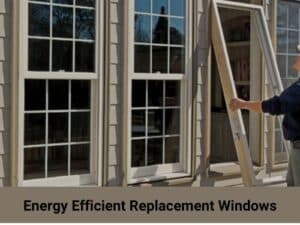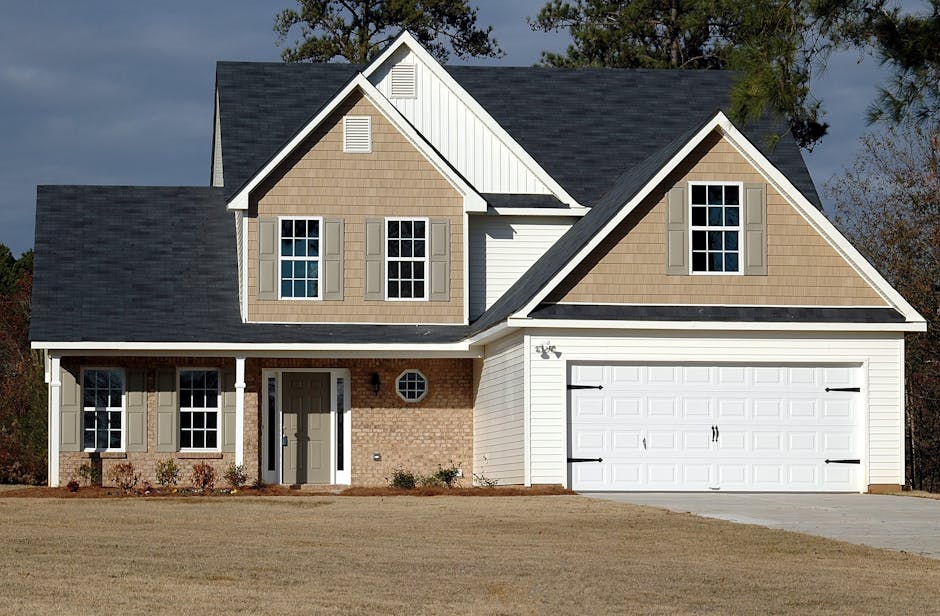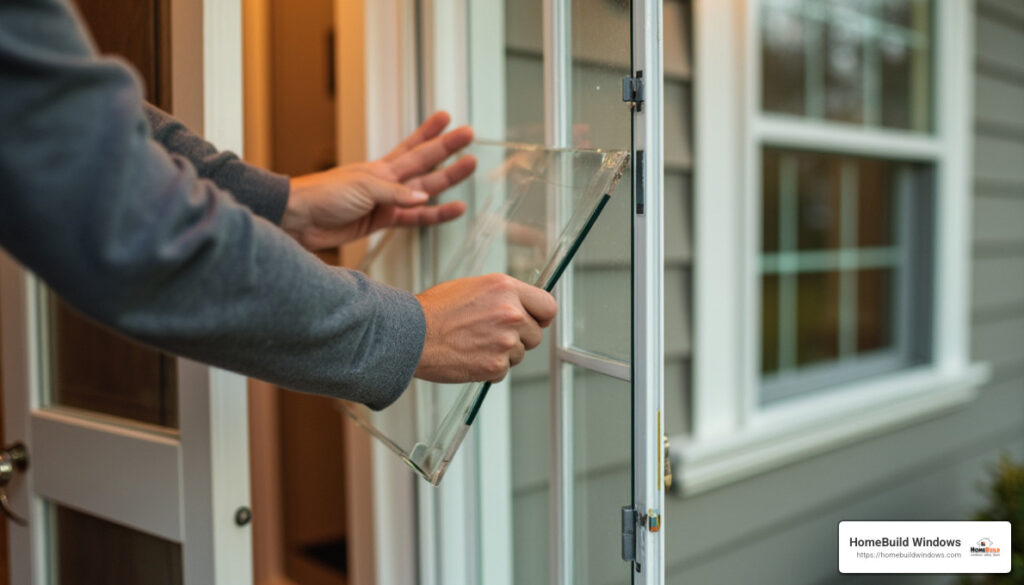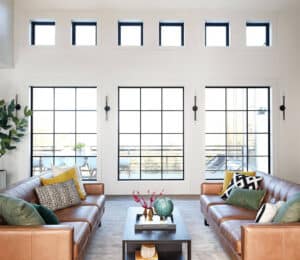Window replacement cost can be a pressing concern for homeowners looking to boost energy efficiency and improve the aesthetic appeal of their homes. Though prices vary based on different factors, a quick snapshot shows:
- Average Costs: Materials range from affordable vinyl to pricier wood or fiberglass.
- Energy Efficiency: Opting for energy-efficient windows can save up to 30% on energy bills.
- Installation: Professional help adds up but ensures quality, whereas DIY might save bucks initially but can lead to issues later.
- Type & Size: Larger and more complex window types (like bay windows) will generally cost more.
In the busy urban homes of Chicago or the serene suburban settings of the North-West suburbs, window replacements aren’t just an option but a necessity for improved home comfort and value.
As the owner and president of HomeBuild Windows, I’m Steve Mlynek. My hands-on experience since 2005 has taught me the ins and outs of window replacement cost. With a commitment to quality and transparency, I aim to guide you in making informed decisions for your home. Next, let’s dive deeper into understanding these costs and factors in detail.
Understanding Window Replacement Cost
When considering a window replacement, understand the factors that influence window replacement cost. Let’s break it down into material and glass type costs.
Material Costs
The material of your window frames is a primary factor affecting costs. Here’s a quick look at the common materials:
-
Vinyl: Known for affordability and low maintenance, vinyl windows are a popular choice. They provide good insulation, which can help reduce energy bills. Expect to pay less for vinyl compared to other materials.
-
Wood: Wood windows offer a classic and neat look but come with a higher price tag. They require regular maintenance, like painting or staining, to protect against the elements. The beauty of wood can improve your home’s curb appeal, but it’s a bigger investment.
-
Aluminum: These frames are strong and lightweight, making them suitable for larger windows. However, aluminum is less energy-efficient due to heat conduction. The cost is moderate but may increase if you need extra insulation features.
-
Fiberglass: Durable and energy-efficient, fiberglass windows are more expensive but offer longevity and low maintenance. They can withstand harsh weather conditions better than vinyl or wood.
Glass Type Costs
The type of glass you choose also impacts the cost of window replacement. Different glass types offer varying levels of energy efficiency and insulation:
-
Single-Pane Glass: The most basic and least expensive option, ranging from $50 to $150 per window. However, it provides poor insulation, leading to higher energy bills.
-
Double-Pane Glass: Consists of two layers of glass with air or gas in between, costing between $150 and $300 per window. It offers better insulation, making it a popular choice for energy savings.
-
Triple-Pane Glass: The most expensive, from $300 to $600 per window. It has three layers for superior insulation, ideal for extreme climates or those seeking maximum energy efficiency.
-
Low-E Glass: This glass type has a special coating that reflects heat while allowing light to pass through. Costs range from $100 to $300 per window, depending on the pane count. It’s great for improving energy efficiency, keeping homes cooler in summer and warmer in winter.
Installation complexity also plays a role in the overall cost. Professional installation ensures a proper fit, reducing future issues, while DIY might save money upfront but can lead to costly repairs if not done correctly.
Understanding these factors can help you make informed decisions when planning your window replacement project. Next, let’s explore the types of windows and their associated costs.
Types of Windows and Their Costs
Choosing the right window type is crucial for balancing aesthetics, functionality, and window replacement cost. Here’s a breakdown of common window types and their price ranges:
Single-Hung Windows
Single-hung windows are the most budget-friendly option, with prices ranging from $100 to $400 per window. In these windows, only the bottom sash moves, making them simple and easy to maintain. They are a great choice for those looking to save on costs without sacrificing basic functionality.
Double-Hung Windows
Double-hung windows offer more flexibility, as both the top and bottom sashes can move. This feature allows for better ventilation and easier cleaning. Prices typically range from $150 to $600 per window. These windows are popular for bedrooms and living areas due to their versatility.
Casement Windows
Casement windows open outward like a door, providing excellent ventilation and a tight seal when closed. They are priced between $200 and $800 per window. Casement windows are ideal for spaces where you want maximum airflow and energy efficiency.
Awning Windows
Awning windows, which open outward from the bottom, are perfect for ventilation even in rainy conditions. They cost between $200 and $700 per window. These windows are often used in bathrooms and kitchens, where moisture control is important.
Bay and Bow Windows
Bay and bow windows are larger and more complex, projecting outward to create a nook or shelf inside the home. They can significantly improve a room’s appearance and value, but come with a higher price tag, ranging from $1,000 to $4,000 per window. These are often used as a stunning focal point in living rooms or dining areas.
Picture Windows
Picture windows are fixed and do not open, designed to provide unobstructed views. They cost between $200 and $1,200 per window. While they offer great aesthetics and natural light, they do not provide ventilation.
Sliding Windows
Sliding windows open horizontally along a track and are priced between $150 and $600 per window. They are easy to operate and maintain, making them a practical choice for many homes, especially in areas with limited space.
Understanding these window types and their costs can help you select the best option for your home and budget. Next, we’ll dive into labor and installation costs to give you a complete picture of your window replacement project.
Labor and Installation Costs
When it comes to window replacement cost, labor and installation are significant components to consider. Let’s break down what you need to know about professional and DIY installations, along with key factors that influence labor costs.
Professional Installation
Hiring a professional to install your windows is often the best choice for most homeowners. Professionals ensure that your windows are installed correctly, reducing the risk of drafts, leaks, and other issues. On average, professional installation costs range from $100 to $300 per window. This cost can vary based on the complexity of the job and the location of the windows. For instance, installing windows on higher floors or in hard-to-reach areas can increase labor costs due to the need for additional equipment and time.
DIY Installation
If you’re handy and have the right tools, you might consider a DIY installation to save on labor costs. However, this approach comes with risks. Improper installation can lead to problems that might cost more to fix than the money saved. For most homeowners, hiring a professional is the best way to ensure the job is done correctly and safely.
Labor Cost Factors
Several factors can influence the labor costs for window replacement:
- Window Type: More complex windows, such as bay or bow windows, require more time and skill to install, increasing labor costs.
- Window Size: Larger windows are heavier and harder to handle, which can also raise labor costs.
- Job Accessibility: Windows on higher floors or in hard-to-reach areas may require special equipment, adding to the labor costs.
- Existing Conditions: If the window frames or surrounding structures are damaged, additional work may be needed to repair them before new windows can be installed.
Understanding these factors will help you anticipate the labor costs associated with your window replacement project and budget accordingly.
Next, we’ll explore the whole house window replacement cost, including potential bulk discounts and energy savings.
Whole House Window Replacement Cost
Replacing all the windows in your home is a big project. But, it can bring a lot of benefits. Let’s explore the details of whole house window replacement cost and what you can expect.
Bulk Discounts
When you replace multiple windows at once, you can often get a better deal. Many suppliers offer bulk discounts that lower the price per window. This can lead to significant savings compared to buying and installing windows one at a time. By coordinating the replacement of all your windows, you also save on labor costs, as installers can work more efficiently.
Energy Savings
New windows can make your home more energy-efficient. Energy-efficient windows help keep your home warm in the winter and cool in the summer. They reduce the workload on your heating and cooling systems, which can lower your energy bills. According to the Department of Energy, installing single-pane windows that meet Energy Star certification standards can reduce household energy bills by an average of 13%. Over time, these savings add up and help offset the initial cost of window replacement.
Increased Home Value
Investing in new windows can also boost your home’s value. While you might not get back every dollar spent, the return on investment for window replacements is typically between 70% to 85%. New windows improve your home’s curb appeal, improve security, and attract potential buyers. These factors make window replacement a smart investment if you’re planning to sell your home in the future.
In summary, while the upfront whole house window replacement cost might seem high, the long-term benefits make it a worthwhile investment. From energy savings to increased home value, new windows offer both immediate and future advantages.
Next, let’s address some frequently asked questions about window replacement costs to help you make informed decisions.
Frequently Asked Questions about Window Replacement Cost
How Often Should Windows Be Replaced?
Windows usually last between 15 and 30 years. However, this can vary depending on the material and how well they are maintained. Look for signs like drafts, condensation between glass panes, or difficulty opening and closing to know when it’s time for a replacement. These issues can increase energy bills and make your home less comfortable.
What Is the Best Material for Window Frames?
Choosing the right material for window frames depends on your budget and needs. Here are the main options:
-
Vinyl: Affordable and low-maintenance. Vinyl windows offer good insulation and can help reduce energy bills. They are a popular choice for many homeowners.
-
Wood: Offers a classic and neat look. However, wood requires more upkeep, such as painting or staining, to protect against weather damage. While more expensive, wood can add a traditional charm to your home.
-
Aluminum: Strong and lightweight, making it suitable for larger windows. However, aluminum is less energy-efficient as it conducts heat, which might increase energy costs.
-
Fiberglass: Durable and energy-efficient but comes with a higher price tag. Fiberglass windows last longer and require less maintenance compared to wood or vinyl.
Are Energy-Efficient Windows Worth the Investment?
Yes, energy-efficient windows are a smart investment. They help keep your home insulated, which reduces the workload on your heating and cooling systems. This can lead to significant energy savings. According to the Department of Energy, energy-efficient windows can cut household energy bills by an average of 13%. Over time, these savings can offset the higher upfront cost of these windows.
Investing in energy-efficient windows also increases your home’s value and improves its comfort. They provide long-term benefits that make the initial investment worthwhile.
Conclusion
Investing in window replacement is a big decision, but it’s one that can pay off in more ways than one. At HomeBuild Windows, we understand the importance of quality, energy efficiency, and durability in every window we install.
Choosing the right windows can significantly improve your home’s comfort and energy efficiency. Our energy-efficient windows are designed to keep your home cozy year-round, reducing heating and cooling costs. With advanced technology like double-pane glass and low-emissivity coatings, our windows help maintain the ideal indoor temperature, leading to long-term savings on energy bills.
Quality is at the heart of everything we do. As an Elite Platinum Pella Certified Contractor, we offer high-quality, customizable products backed by a Pella Limited Lifetime Warranty. This ensures that your investment is protected, giving you peace of mind and confidence in your choice.
Moreover, replacing your windows is not just about comfort and savings; it also boosts your home’s value and curb appeal. With a return on investment estimated between 70% to 85%, new windows can make your home more attractive to potential buyers.
Ready to improve your home’s view and value? Explore our window replacement and installation services to see how we can help you make the right choice for your home.







